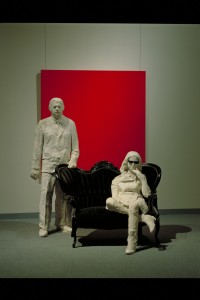
The new show “Robert and Ethel Scull: portrait of a collection” at Acquavella Galleries is a must-see, not only to marvel at some of what the Sculls once possessed, but to reflect on where the art world was then and is now.
The show includes a Jasper Johns’ trifecta: Map, donated to the Museum of Modern Art by the Sculls, as well one of his exquisite target paintings and a monumental double flag painting. There’s an early Frank Stella shaped canvas, and a fabulous early Rosenquist. Their collecting achievement was specific to their time, though; there are no Sculls today. It’s important to look at why.
Robert Scull, whose real name was Ruby Sokolnifoff, married Ethel, a well-to-do girl whose father owned a fleet of taxicabs, in the mid-1940s. Robert took over and grew the business successfully; he and Ethel discovered the art world and a whole social universe. They bought quantities of artworks with monies he borrowed against the business. It’s hard to imagine that a taxicab fleet owner was ever an extraordinarily wealthy man, not in the ’60s and not today. So how was it possible for the Sculls to live on Fifth Avenue and buy so many desirable works by Jasper Johns and Robert Rauschenberg, and commission Andy Warhol to do a portrait of Ethel that comprised 36 panels? The market was in its infancy, and there were few collectors and little money for contemporary art, and thus a savvy, self-promoting parvenu could buy up everything, if he had an eye for some of the best and most challenging works.
Robert was forthright about his activities and intentions; once asked by an interviewer about accusations that he and his wife bought art for investment and for social climbing, he replied: “It’s all true. I’d rather use art to climb than anything else.”
Having pioneered the concept of the mega-collector, Robert then changed the art market forever. He and Ethel were heading toward what became a vicious divorce, so he put a large portion of the collection up at auction in 1973 and sold the lot of it at Parke-Bernet for more than $2.2 million. The sale set records for Johns, Rauschenberg and Warhol, among others. Warhol was apparently pleased with the result but miffed that his did not bring the highest price. But most of the others felt totally betrayed by the auction stunt and publicity. According to Ethel Scull, after the sale, Robert Rauschenberg said to Robert, “I’ve been working my ass off just for you to make that profit,” and Scull responded, “It works for you, too, Bob. Now I hope you’ll get even bigger prices.” At which point, apparently, Rauschenberg punched him in the stomach and walked off. But history has proven Robert Scull right.
That type of auction success ultimately helped catapult the art market. Today’s prices bear little resemblance to what they once were; today’s values are roughly 100 times greater. The whole market is also exponentially bigger, so it is no longer possible to amass the range and quality the Sculls did, unless the budget is multiplied a hundred times. Art is an asset class. Despite the economic crisis, prices for works by many artists have largely held up, as has the Sculls’ reputation.
The Sculls were important patrons at a time when the contemporary art world first became a scene. Despite Robert’s joke, they were focused not only on profits; they donated some works and commissioned others, like earthworks by Michael Heizer. These were exciting outdoor projects that would never be moneymakers, so characterizing the Sculls as mere social climbers and profiteers has simply not proven true.
But the art world they inhabited consisted of just a handful of dealers representing a short list of artists. Contemporary art was cheap and dealers had a hard time selling anything, and let’s not forget the Sculls’ world was New York City. They collected only what they found in the New York art world, a small pond in which a little flash of cash made them big fish. Today’s art world is so completely different; it is extremely international, with dozens of artists from all over the world, and unlike the good old days, dealers have lots of collectors to chose from for the most desirable works.
The days when a modest budget could allow the Sculls to scoop up some of the best art of an entire generation are over. Today, only the most dedicated and committed collectors can compete, and they each need to seek out a niche where they gain the best access. The Sculls of today are the collectors who aren’t using old formulas but are discovering, promoting, curating and thus changing the traditional roles in the art world. That’s really what Robert Scull succeeded in doing, changing the rules of his time, and he was right all along when he said, “It works for you, too.”
